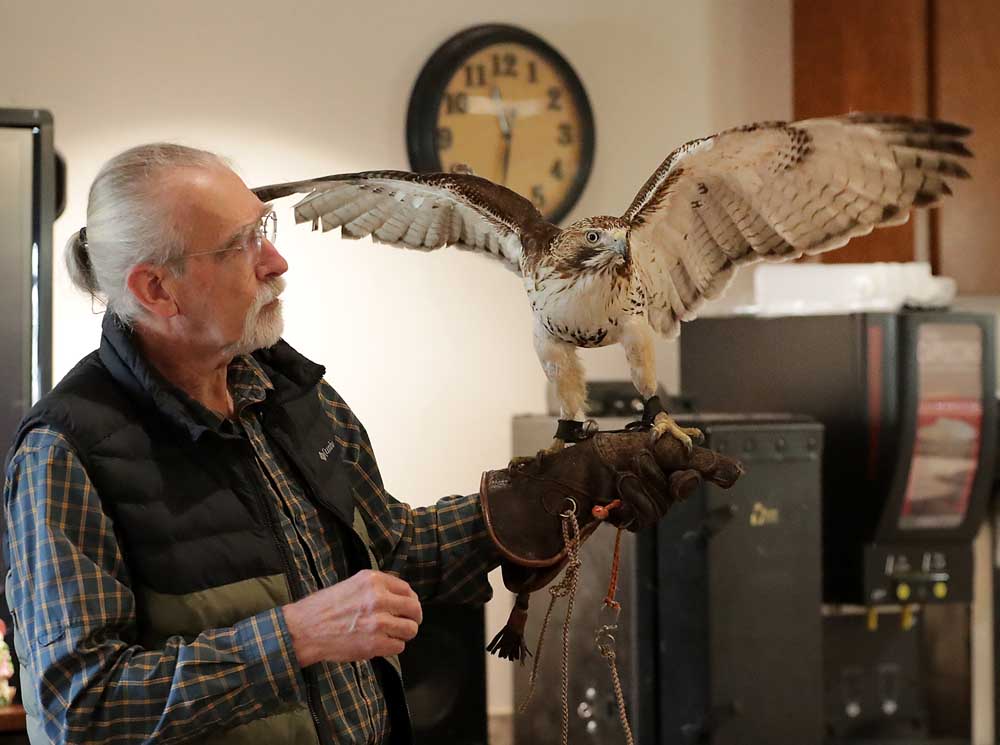Interview with a falconer: Jacksonville book club gets up-close view
Published 6:00 am Saturday, April 15, 2023

- Jim Webber takes questions Friday about his red-tailed hawk, Sasquatch, during a presentation at Pioneer Village in Jacksonville.
Residents of a Jacksonville retirement home enjoyed an interview with a falconer Friday morning to complement a book club reading of Helen Macdonald’s “H is for Hawk.”
“Falconry is a hobby, a sport, and it’s really a lifestyle. It’s the sport of hunting wild quarry in its native habitat with a trained raptor,” said Jim Webber, president of the Oregon Falconry Association.
His current raptor — a red-tailed hawk named Sasquatch — waited in an enclosed carrier nearby to be revealed after his listeners had their fill of falconry knowledge.
The book club at Pioneer Village retirement home has been reading Macdonald’s book, and Linda Robb, a former teacher who helps run the club, said Webber’s visit was an attempt to spark inspiration in a beleaguered group of readers.
“I’m always trying to force, ‘Let’s learn something new, something new every day.’ Expand genres if they keep picking just one. ‘H is for Hawk’ — it was a little bit difficult, they were having trouble with it,” she said.
Robb spent weeks trying to arrange a keeper of raptors to come speak to the club. Some were unavailable; some quoted high price tags. Webber was not only available, but refused any pay and drove from Bend to Jacksonville to share his expertise for free.
The club members sat fixated as Webber spoke. Their walkers were parked and their canes held under their chins as he explained all the ways his sport is a part of nature red in tooth and claw.
“It’s all a part of the balance of nature. They have certain instincts, we as humans learned to take advantage of those. The hawk learns we can chase out game and help it hunt, and it learns to follow us and hunt with us,” he said.
Many different species of raptors can be used for the sport, he said. Most use the vice-like grip of their talons combined with sports car speeds and their curved beaks to hunt.
Falcons — like buteos (properly called buzzards), accipiters, prairie falcons and peregrine falcons — are all used in the sport. Smaller raptors such as kestrels and merlins have their place, too. Then there are red-tailed hawks and eagle hawks.
Each species has its benefits, he explained. The smaller birds like kestrels or even red-tailed hawks can be more maneuverable and faster, while larger birds have more power. Smaller raptors might hunt songbirds, while larger birds take down prey such as rabbits.
Webber recalled seeing nature in all its cruel beauty while hunting rabbits with his hawks at home in Bend.
“They’re good athletes. I’ve been amazed sometimes watching them run from my hawks. Sometimes they’ll run up practically vertical slopes, jumping from rock face to rock face,” he said.
He reminded his audience they have seen hawks hunting frequently, in flocks of starlings.
“If you’ve ever seen those clouds of birds that move from light to dark — there’s going to be a falcon in the middle causing them to make those defensive movements. It confuses the raptors,” he said.
The hawks have owls to contend with, he said. The two species hate each other like cats and dogs.
“One of my biggest fears when I’m out with my hawk is that somehow an owl will get scared out of its hiding spot. Because then my hawk is gonna go for it. If my hawk is out at night, and an owl gets it, the owl could kill it,” he said.
Most hawks don’t live to maturity, he said. Up to 70% of hawks born in the wild will die before they reach one year of age.
“Nature can be cruel. They die of starvation, disease and predators,” he said.
Falconers capture their raptors before they’re a year old. In his own 27 years of falconry, Webber has largely chosen to release his hawks after a year of working with them.
For a falconer of his experience level, it’s possible to have a raptor trained and ready to hunt within two weeks. A less-experienced falconer might take months to have their bird in the air.
Becoming a falconer is a multi-year endeavor, he said. In Oregon, there are eight steps, including a 500-question exam with a mandatory score of 80% or higher, a two-year apprenticeship, and licenses with the state of Oregon and the Oregon Department of Forestry.
Macdonald’s story in “H is for Hawks” was part of what compelled Webber to come and speak to the retired readers. Macdonald’s autobiographical book details the way falconry shaped her father-daughter relationship. Webber got into hawks through his own daughter.
“When she was about 8 years old, she loved birds and she loved to draw, especially raptors and dinosaurs. So we started going to animal rehabilitation places, and a lot of those people will rely on falconers for a cursory evaluation if birds can be released into the wild. We know what to look for in a healthy falcon when it’s flying,” he said.
Once his daughter, Carrie, was introduced to falconry, it was a natural fit. Father followed daughter into the world of hunting with raptors.
As he prepared to release Sasquatch from her enclosure, he pulled on a leather glove and fastened it around his hand and wrist. He unzipped the bird’s black fabric enclosure, and Sasquatch climbed into the glove. She stood looking over the audience with her penetrating gaze. She swiveled her head in rapid motions, searching the room for threats or prey. After a few minutes on the glove, she ruffled all her feathers and let them smooth out again.
“You see what she just did there? That’s called ‘baiting.’ It helps all the feathers lay smooth against each other again. They only do that when they’re comfortable. So she doesn’t sense a threat from any of you,” he said.
He held up Sasquatch’s feet for the audience to admire their size, the reason for her name. When asked to “show your wingspan,” she complied, stretching her dappled wings. A bell jingled around her ankle as she moved.
“Nowadays, we can use transmitters attached to their ankles, but to keep looking at my phone to see if she’s following me is a nuisance. If I can hear the bell, I know she’s following me. And she is just a princess on the glove. She follows like a forlorn teenager, but when she sees a cottontail, the chainsaw comes out,” he said.
The audience needed little prodding to ask questions. Webber was peppered with inquiries like “How much does she weigh?” “What do you feed her?” “Do you ever worry she’ll hurt you?”
Sasquatch weighs two pounds, but she’s in the midst of being fattened for a hawk’s annual molting season. She enjoys gophers trapped for her, the cleaned-up meat of her own kills, and frozen quail, Webber said.
As to the risk of keeping raptors, Webber answered in his candid style.
“With my second or third hawk, back when I was a dumb kid — of, you know, 45 — I got a little bit careless and the hawk’s talon went straight through my hand,” he said. “The talons are the business end of the hawk.”
As Webber closed his presentation and returned an increasingly restless hawk to her enclosure, two book club members could be heard whispering in the second row — “You want to read the book again?”






